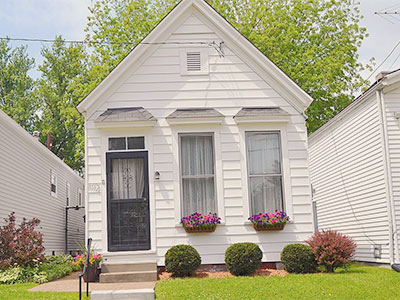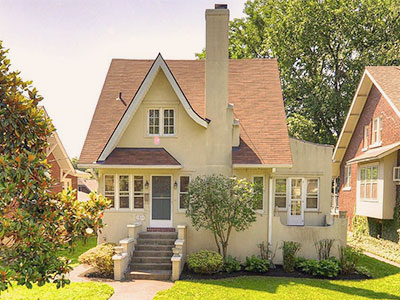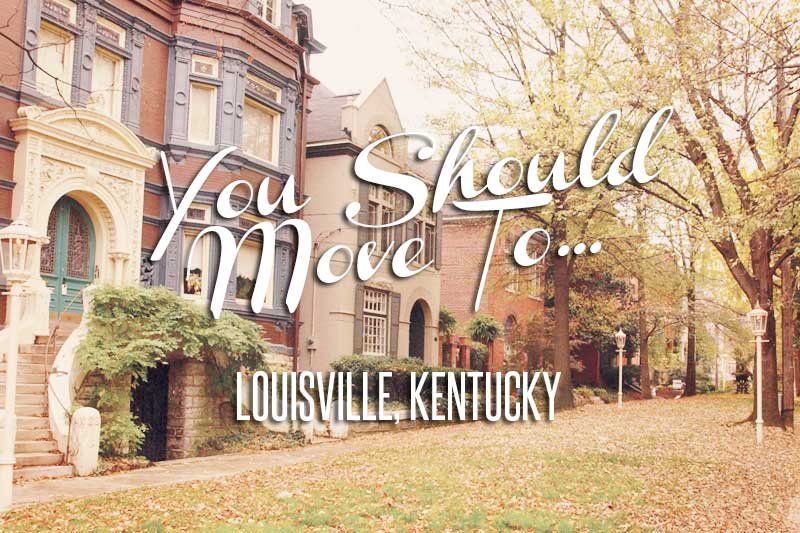by Lindsay Riddell (image courtesy of UofL Cardbook)
Welcome to “You Should Move To…”, in which Lindsay travels the country scoping out beautiful, under-the-radar old house-filled cities and towns where big charm can be had for little cost. Have a city, town or neighborhood to recommend? Send it along to [email protected]!
Founded in 1778 and named in honor of Louis XVI, Kentucky’s most famous city is a little bit Southern and a little bit Midwestern. Located on the border of Indiana and Kentucky, and home to flavored chewing gum, bourbon, and the Kentucky Derby, Louisville is the oldest city west of the Appalachian Mountains. The city was an important post during the Civil War and a centre of manufacturing during World War II. Its nineteenth and twentieth century wealth is reflected in its architecture: the cityscape is dotted with federal style houses, the second largest cast iron district in the country, rows of Victorian Gothic and Romanesque Revival mansions, Craftsman bungalows, and brick industrial buildings.

Old Louisville.

Old Louisville. Photo by Summit Musings.
In 1937 Louisville was hit by a storm that flooded most of the city, submerging over seventy percent of its buildings. Nearly one quarter million residents evacuated the city, many of whom never returned. The property and population loss caused by the flood marked the first wave of migration out of the city, and the beginning of disinvestment. Following the end of the war, military manufacturing transitioned to heavy industrial and agricultural machinery, which almost entirely disappeared within a decade, leaving many unemployed. Residents and businesses quickly left the decaying city. With little economic opportunity present, and as many parts of Louisville were condemned as “blighted”, the 1960s and 1970s were decades of substantial migration from the urban centre to the suburbs. Only the poorest remained in Louisville, attracted to the low room rents in the divided mansions that were once home to the city’s elite.

St. James Court’s “Pink Palace”.
Beginning in the 1980s, and after residents fought to preserve Old Louisville’s character, revitalization of many areas of the city began. By the early 2000s, this effort manifested iteself in numerous neighborhoods and on many commercial streets, including Bardstown Road Corridor, Frankfort Avenue, Old Louisville, the former industrial waterfront, and the West and South Ends. Louisville is today a vibrant city with the preservation of communities and the restoration of its old buildings running the show.

The beautiful c. 1865 Gabler House is for sale for $699,000. Full listing HERE.
In spite of its revitalization, Louisville is almost completely under the radar. That means cheap old houses galore! In spite of its recovery at the turn of this century, there are still countless Victorians going for under $300,000 (according to Old House Online, Louisville has the largest number of contiguous Victorian-era houses in the United States). I couldn’t believe my own eyes when I came across this seven bedroom, 5000 square foot house for $325k. Louisville is a great place to invest in rental property, too. In recent years there’s been a huge influx of college students. For just over $300k you can snag a four-unit income property. That mortgage will be paid off in no time!
There’s something for every budget and stylistic preference in Louisville. Prefer Craftsmans? How about this little gem going for $85,000? It’s hard to say no to a deal like that! Whether your budget is $500,000 or $50,000, whether you’re looking for a factory loft conversion or a single-family Queen Anne, you should move to Louisville!

The Louisville Science Center. Photo by merfam.
LOUISVILLE HOUSES FOR UNDER $400,000:
[twocol_one] 132 MCCREADY AVENUE, c. 1935
132 MCCREADY AVENUE, c. 1935
$319,900
[/twocol_one] [twocol_one_last] 1033 CHARLES STREET, c. 1900
1033 CHARLES STREET, c. 1900
$179,900
[/twocol_one_last]
[twocol_one]
 1650 BEECHWOOD AVENUE, c. 1850
1650 BEECHWOOD AVENUE, c. 1850
$349,900
[/twocol_one] [twocol_one_last] 2214 WOODBOURNE AVENUE, c. 1922
2214 WOODBOURNE AVENUE, c. 1922
$294,900
[/twocol_one_last]
[twocol_one]

4633 S 3RD STREET, c. 1915
$140,000
[/twocol_one] [twocol_one_last] 115 CRESTWOOD AVENUE, c. 1928
115 CRESTWOOD AVENUE, c. 1928
$314,900
[/twocol_one_last]
[twocol_one]

710 GWENDOLYN STREET, c. 1906
$74,900
[/twocol_one] [twocol_one_last] 1625 RICHMOND DRIVE, c.1915
1625 RICHMOND DRIVE, c.1915
$299,900
[/twocol_one_last]
[twocol_one]

2145 ALGONQUIN PARKWAY, c. 1926
$95,000
[/twocol_one] [twocol_one_last] 3762 CRAIG AVENUE, c. 1900
3762 CRAIG AVENUE, c. 1900
$110,000
[/twocol_one_last]
[twocol_one]

705 E HILL STREET, c. 1900
$71,250
[/twocol_one] [twocol_one_last] 1438 S 1ST STREET, c. 1902
1438 S 1ST STREET, c. 1902
$309,500
[/twocol_one_last]
[twocol_one]

2128 NEW MAIN STREET, c. 1900
$250,000
[/twocol_one] [twocol_one_last] 3600 BANK STREET, c. 1911
3600 BANK STREET, c. 1911
$57,900
[/twocol_one_last]
[twocol_one]

628 HARRISON AVENUE, c. 1925
$184,500
[/twocol_one] [twocol_one_last]
1218 S 6TH STREET, c. 1890
$239,000
[/twocol_one_last]
[twocol_one]

2102 SPEED AVENUE, c. 1910
$205,000
[/twocol_one] [twocol_one_last] 2363 WINSTON AVENUE, c. 1936
2363 WINSTON AVENUE, c. 1936
$225,000
[/twocol_one_last]
[twocol_one]

610 MYRTLE STREET, c. 1900
$110,000
[/twocol_one] [twocol_one_last] 1208 S 2ND STREET, c. 1884
1208 S 2ND STREET, c. 1884
$360,000
[/twocol_one_last]
[twocol_one]

2026 ALEXANDER AVENUE, c. 1920
$130,000
[/twocol_one] [twocol_one_last] 2701 LEXINGTON ROAD, c. 1935
2701 LEXINGTON ROAD, c. 1935
$315,000
[/twocol_one_last]
[twocol_one]

224 E ORMSBY AVENUE, c. 1902
$179,000
[/twocol_one] [twocol_one_last] 1205 RAMMERS AVENUE, c. 1905
1205 RAMMERS AVENUE, c. 1905
$95,000
[/twocol_one_last]
[twocol_one]

1848 EDGELAND AVENUE, c. 1905
$294,900
[/twocol_one] [twocol_one_last] 2231 ROWAN STREET, c. 1900
2231 ROWAN STREET, c. 1900
$25,000
[/twocol_one_last]
[twocol_one]

182 CORAL AVENUE, c. 1905
$274,950
[/twocol_one] [twocol_one_last] 1112 SCHILLER AVENUE, c. 1895
1112 SCHILLER AVENUE, c. 1895
$120,000
[/twocol_one_last]
[twocol_one]

1838 ROANOKE AVENUE, c. 1920
$235,000
[/twocol_one] [twocol_one_last] 2225 VALLEY VISTA ROAD, c. 1926
2225 VALLEY VISTA ROAD, c. 1926
$399,000
[/twocol_one_last]
[twocol_one]

132 STOLL AVENUE, c. 1895
$249,900
[/twocol_one] [twocol_one_last] 1086 E KENTUCKY STREET, c. 1900
1086 E KENTUCKY STREET, c. 1900
$121,900
[/twocol_one_last]
[twocol_one]

1835 ROANOKE AVENUE, c. 1925
$235,000
[/twocol_one] [twocol_one_last]
[/twocol_one_last]





